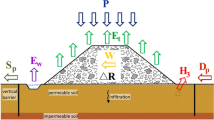Abstract.
Landfilling is the most economical and commonly used final disposal method of municipal solid and hazardous wastes. Leachate, which is the inevitable output of the landfills, may cause serious pollution problems if not properly handled. In this study, the hydrologic evaluation of landfill performance (HELP) model was used to examine the performance of the hazardous waste lot (HWL) of Izmit Industrial and Domestic Solid Waste Sanitary Landfill for three different cases. These cases were the (1) existing design, (2) design in the revision plan prepared by IZAYDAS (Izmit Waste and Residue Treatment, Incineration, and Recycling Co.) Inc. and (3) the minimum design requirement of the Turkish Regulation on the Control of Hazardous Waste (RCHW). Results revealed that leachate collected by the drainage layers of the base system for case 2 (IZAYDAS revision plan) is more than that of case 3 (minimum requirement of the Turkish RCHW case); and the percolation rates for all the cases are very close to each other and can be considered to be the same for all practical purposes.
Similar content being viewed by others
Author information
Authors and Affiliations
Additional information
Electronic Publication
Rights and permissions
About this article
Cite this article
Yalçin, .F., Demirer, .G. Performance evaluation of landfills with the HELP (hydrologic evaluation of landfill performance) model: Izmit case study. Env Geol 42, 793–799 (2002). https://doi.org/10.1007/s00254-002-0582-3
Received:
Accepted:
Issue Date:
DOI: https://doi.org/10.1007/s00254-002-0582-3




